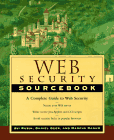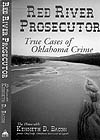| |

|
Navigation |
|
Vol. 72, No. 10, October
1999 |
 Previous
Page Previous
Page
Book Reviews
This Month's Featured Selections
 Web Security Sourcebook:
Web Security Sourcebook:
A Complete Guide to Web Security
Threats and Solutions
By Aviel D. Rubin, Daniel Geer, and Marcus J. Ranum
(New York, NY: Wiley Computer Publishing, 1997).
Paper. 416 pgs. $23.99.
Reviewed by Bruce P. Bower
This book is titled a "sourcebook" and that it is.
The work gives detailed treatment to various security aspects
of the Web.
The volume begins with a brief history of the Internet, and
gives an overview of security threats. The book is not specific
to law offices, but the threats discussed - to integrity
of information, confidentiality, denial of service, and authentication
- will concern many different users of the Web. The authors
discuss the consequences of these threats, and countermeasures.
For the more general audience, the work treats browser security,
and Common Gateway Interface (CGI) issues. Those who use intranets
will find the authors' treatment of firewalls informative.
The Internet is becoming more important
for transactions and for electronic commerce. This book discusses
transaction security, Internet Protocol Security, secure payment
protocols, search engine security, and risk apportionment. Thus,
those who engage in electronic commerce (and their lawyers) will
find this work relevant. An appendix provides additional information
on aspects of cryptography - such as encryption, decryption,
and digital signatures.
The authors provide a lengthy set of further references. Numerous
additional books and organizations are listed. Throughout the
work, and again at the end, many related Web sites are identified
and their URLs (Uniform Resource Locators) provided. The book
is also replete with references to individuals who have been
involved in Web security issues. For those who need to locate
expertise on Web security, this work can provide leads.
The authors used a varied, effective layout. Charts, tips,
and warnings are interspersed among the text discussion. A lengthy
index is provided.
Webmasters and computer savants will find this volume accessible.
Newbies will want to be armed with a good computer dictionary.
Bruce P. Bower, Notre Dame 1975, serves
as a public member on the State of Texas Electronic Benefits
Transfer Task Force.
 What Can You Do with a Law Degree?
What Can You Do with a Law Degree?
A Lawyer's Guide to Career Alternatives
Inside, Outside & Around the Law
By Deborah Arron
(Seattle, WA: Niche Press, 1999).
Paper. 400 pgs. $29.95.
Reviewed by Theresa L. Schulz
Deborah Arron has created another timely, easy-to-read, comprehensive
guide in What Can You Do With A Law Degree? A Lawyer's
Guide to Career Alternatives Inside, Outside & Around the
Law, 4th edition. This book is not just for the unemployed
or unsuccessful lawyer, it's also for new law school graduates,
retired attorneys, attorneys returning from parental leave, and
those who may be burned out, disenchanted, or bored by their
jobs.
This book takes you step-by-step through a process designed
to help you identify and secure your ideal job, which may not
be your current job. Even if you're not looking for a job
change, this book provides the tools for analyzing your current
position against your strengths and desires. The book provides
a series of self-assessment exercises to help pinpoint your skills,
interests, and values. With that information, the book shows
how to research the job possibilities, conduct the job hunt,
and land the ideal job.
This book is refreshingly upbeat and
encouraging. Arron does not further the attitude that if you
don't land the high-paying associate position at a large
law firm, something is wrong with you. Instead, Arron shows that
if you're not as successful or satisfied in your current
job as other lawyers may be, it just shows they're in the
right place and you're not. You will be successful and satisfied
when you find the right position for you.
Though optimistic, this book is not unrealistic. In fact,
it addresses hard issues like why we may be resistant to change
and how to overcome barriers when changing the status quo. The
book also considers when is the right time for a change, how
to prepare for that time, and how to make the adjustment.
Theresa L. Schulz, Minnesota 1993, practices
employment law in Wisconsin and Minnesota from her office in
Lake Elmo, Minn.
 Red River Prosecutor:
Red River Prosecutor:
True Cases of Oklahoma Crime
By Kenneth J. Bacon
(Lakeville, MN: Galde Press, 1998).
Hard. 320 pgs. $19.95.
To order, (800) 777-3454.
Reviewed by Lorinne J. Cunningham
Love County, Okla., is on the southern boundary of the state,
separated from Texas by the Red River. During the 1960s, Love
County was joined to its southern neighbor by a single bridge
spanning the slow-moving river, and the road to Texas was lined
with a mile-long parade of beer joints and saloons called "The
Strip" that attracted the outlaws and rowdies from both
states.
In Red River Prosecutor, Ken Bacon recounts his adventures
as Love County's prosecutor during that period. The book
is largely a collection of anecdotes, written in an accessible,
entertaining vernacular for the nonlawyer, and peopled with an
array of outrageous characters, good and bad alike, moving through
episodes of arson, murder, robbery, and worse.
Bacon's adventures will strike other prosecuting attorneys
much as the adventures of TV's "Quincy" strike
pathologists: much too hands-on to ring true. Bacon avers he
was present at the crime scene or apprehension of virtually every
criminal who appears in the book, an oddity he explains briefly
in the Introduction as his attempt to preserve evidence from
careless or inexperienced law enforcement officers.
Bacon seldom strays into explaining some
point of law or describing some legal battle - a pity because
some of his shining moments as an author come from using his
accessible style to explain concepts difficult for the lay reader.
In one instance, he likens a courtroom argument with opposing
counsel to a fistfight, moving back and forth between metaphor
and the events as they occurred to vibrantly explain civil procedure
to the nonprofessional.
From the lawyer's perspective, Bacon's choice of
emphasis limits the book's interest for members of the bar.
More importantly, as careful readers with highly developed analytical
and interpretive skills, lawyers may question Bacon's role
in the events described. Often, his "eyewitness" accounts
are clearly tagged as hearsay or historical; in others his role
must be gleaned from the context. The discerning reader may find
blatant errors as well, such as when the author, present at an
autopsy, explains "[t]he stiffness of a dead person's
body will leave after a certain length of time and it won't
stiffen up again until later." Even a novice investigator
will tell you the opposite is true: The order of events is that
a limp corpse will stiffen with rigor mortis, and in time will
go flaccid again.
If the raw material for Bacon's book is entertaining,
he does a less than effective job of tying the whole together.
Bacon's stated purpose, in addition to memorializing his
experiences for his descendants, is to influence his readers'
opinions concerning the criminal justice system, specifically,
by encouraging participation in the jury system and, more subtly,
by intimating why police "toughness" is necessary.
This purpose, however, is largely lost as the author's message
is awkwardly placed throughout the book, and the events described
often lead to the opposite conclusion. In any case, Red River
Prosecutor is a likable read, and need make no apologies
for its value as amusement.
Lorinne J. Cunningham, Chicago-Kent
1996, is an associate at Kohner, Mann & Kailas S.C., Milwaukee,
a firm focusing in commercial law and creditor's rights.
She previously was a technician at a private forensic lab in
northern Illinois.
|
